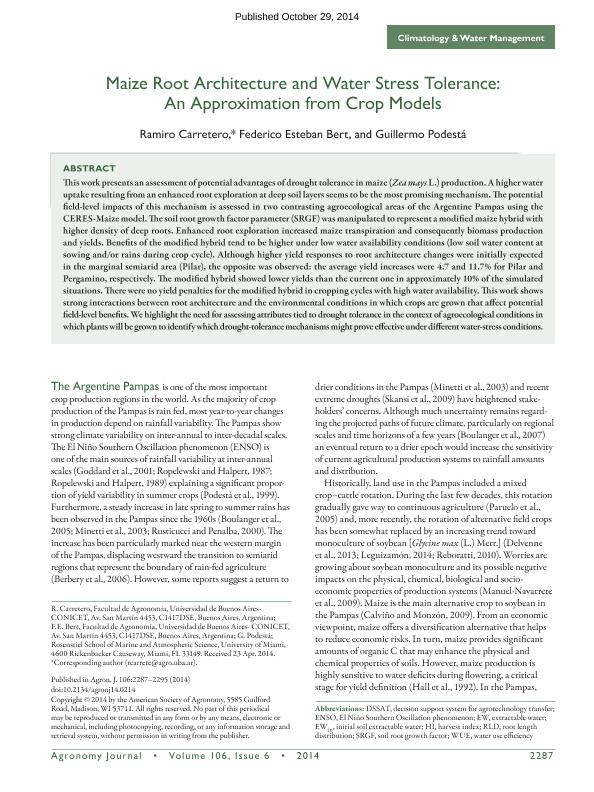Mostrar el registro sencillo del ítem
dc.contributor.author
Carretero, Ramiro

dc.contributor.author
Bert, Federico Esteban

dc.contributor.author
Podestá, Guillermo
dc.date.available
2017-05-10T19:21:21Z
dc.date.issued
2014-12
dc.identifier.citation
Carretero, Ramiro; Bert, Federico Esteban; Podestá, Guillermo; Maize root architecture and water stress tolerance: an approximation from crop models; Amer Soc Agronomy; Agronomy Journal; 106; 6; 12-2014; 2287-2295
dc.identifier.uri
http://hdl.handle.net/11336/16236
dc.description.abstract
This work presents an assessment of potential advantages of drought tolerance in maize (Zea mays L.) production. A higher water uptake resulting from an enhanced root exploration at deep soil layers seems to be the most promising mechanism. The potential field-level impacts of this mechanism is assessed in two contrasting agroecological areas of the Argentine Pampas using the CERES-Maize model. The soil root growth factor parameter (SRGF) was manipulated to represent a modified maize hybrid with higher density of deep roots. Enhanced root exploration increased maize transpiration and consequently biomass production and yields. Benefits of the modified hybrid tend to be higher under low water availability conditions (low soil water content at sowing and/or rains during crop cycle). Although higher yield responses to root architecture changes were initially expected in the marginal semiarid area (Pilar), the opposite was observed: the average yield increases were 4.7 and 11.7% for Pilar and Pergamino, respectively. The modified hybrid showed lower yields than the current one in approximately 10% of the simulated situations. There were no yield penalties for the modified hybrid in cropping cycles with high water availability. This work shows strong interactions between root architecture and the environmental conditions in which crops are grown that affect potential field-level benefits. We highlight the need for assessing attributes tied to drought tolerance in the context of agroecological conditions in which plants will be grown to identify which drought-tolerance mechanisms might prove effective under different water-stress conditions.
dc.format
application/pdf
dc.language.iso
eng
dc.publisher
Amer Soc Agronomy

dc.rights
info:eu-repo/semantics/openAccess
dc.rights.uri
https://creativecommons.org/licenses/by-nc-sa/2.5/ar/
dc.subject
Drought Tolerance
dc.subject
Crop Models
dc.subject
Root Architecture
dc.subject.classification
Agricultura

dc.subject.classification
Agricultura, Silvicultura y Pesca

dc.subject.classification
CIENCIAS AGRÍCOLAS

dc.title
Maize root architecture and water stress tolerance: an approximation from crop models
dc.type
info:eu-repo/semantics/article
dc.type
info:ar-repo/semantics/artículo
dc.type
info:eu-repo/semantics/publishedVersion
dc.date.updated
2017-04-25T13:28:10Z
dc.identifier.eissn
1435-0645
dc.journal.volume
106
dc.journal.number
6
dc.journal.pagination
2287-2295
dc.journal.pais
Estados Unidos

dc.journal.ciudad
Madison
dc.description.fil
Fil: Carretero, Ramiro. Universidad de Buenos Aires. Facultad de Agronomia; Argentina. Consejo Nacional de Investigaciones Científicas y Técnicas; Argentina
dc.description.fil
Fil: Bert, Federico Esteban. Universidad de Buenos Aires. Facultad de Agronomia; Argentina. Consejo Nacional de Investigaciones Científicas y Técnicas; Argentina
dc.description.fil
Fil: Podestá, Guillermo. University of Miami; Estados Unidos
dc.journal.title
Agronomy Journal

dc.relation.alternativeid
info:eu-repo/semantics/altIdentifier/doi/http://dx.doi.org/10.2134/agronj14.0214
dc.relation.alternativeid
info:eu-repo/semantics/altIdentifier/url/https://dl.sciencesocieties.org/publications/aj/abstracts/106/6/2287
Archivos asociados
